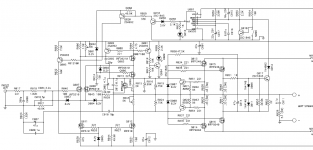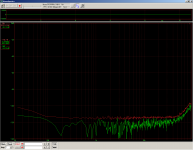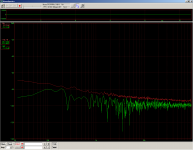How to cure noise in Andom GFA5200 amp?
Noise is not form power (50 Hz and harmonics) but high frequency hum from about 1 kHz and up. Very annoying for good sounding amp if using sensitive speakers.
Can be that input FETs IRFD210 are noisy and only way to get noise down is to replace this with better ones. What can be better?
Attached is GFA5300 schematic, GFA5200 is basically same only power and protection is different and it has only one pair output FETs.
Noise is not form power (50 Hz and harmonics) but high frequency hum from about 1 kHz and up. Very annoying for good sounding amp if using sensitive speakers.
Can be that input FETs IRFD210 are noisy and only way to get noise down is to replace this with better ones. What can be better?
Attached is GFA5300 schematic, GFA5200 is basically same only power and protection is different and it has only one pair output FETs.
Attachments
You need to isolate where the noise is coming from, otherwise we only have guesswork to rely on for troubleshooting this unusual Mosfet/BJT design. For starters, before looking inside, is the noise continuous and the same in both channels? the same with no input source and inputs grounded/not grounded ?
Also (and sorry to raise trivial matters) is the amplifier case grounded (3 pin cord) and do you have any switch mode power supplies or flourescent lamps, CFLs, halogen desklamp etc near the power, signal or speaker leads?
Also (and sorry to raise trivial matters) is the amplifier case grounded (3 pin cord) and do you have any switch mode power supplies or flourescent lamps, CFLs, halogen desklamp etc near the power, signal or speaker leads?
do you have any switch mode power supplies or flourescent lamps,
CFLs, halogen desklamp etc near the power, signal or speaker leads?
Yes, try listening very late at night (or very early in the morning), with all your other appliances turned off,
and see if the noise is still there. Are you in a single family building? Light dimmers can make such noises,
for example. Also try listening with both inputs shorted, to verify that other components are not to blame.
Last edited:
I am pretty sure it is amplifier noise, not external noise.
It is continuous and same in both channels.
I made some measurements with sound card, amp load is 7 ohms, sound card input sensitivity is adjusted so that -3 dB level is 1 V RMS on amp output, amp input is grounded. I not find any difference in noise, is input grounded or open.
First image is base noise level of sound card and load, all connected but amp tuned off, second is amp tuned on.
Actually it seems quite pink noise, but from speakers it will heard/feel like high frequency noise.
It is continuous and same in both channels.
I made some measurements with sound card, amp load is 7 ohms, sound card input sensitivity is adjusted so that -3 dB level is 1 V RMS on amp output, amp input is grounded. I not find any difference in noise, is input grounded or open.
First image is base noise level of sound card and load, all connected but amp tuned off, second is amp tuned on.
Actually it seems quite pink noise, but from speakers it will heard/feel like high frequency noise.
Attachments
The spectra are good to see but as you say the noise is the same from either channel, it is most likely to have a common source. In other words, it is less likely to come from the amplifiers themselves. The noise levels and content would show some inconsistencies between channels if that were the case.
Since noise it is not entering via the signal inputs, it must be entering via the power supply if you remove the speakers when using a dummy load. This still does not eliminate external noise sources. Noise on the mains supply, nearby RFI generating equipment etc? As Rayma suggested, take another look at the noise in quiet periods when people are not using PCs, appliances, Low voltage lighting etc.
The alternative is simply take the amplifier to another location such as friend's place where there is already a sound system, different player, preamp, speakers etc and retest for consistent measurements there.
Since noise it is not entering via the signal inputs, it must be entering via the power supply if you remove the speakers when using a dummy load. This still does not eliminate external noise sources. Noise on the mains supply, nearby RFI generating equipment etc? As Rayma suggested, take another look at the noise in quiet periods when people are not using PCs, appliances, Low voltage lighting etc.
The alternative is simply take the amplifier to another location such as friend's place where there is already a sound system, different player, preamp, speakers etc and retest for consistent measurements there.
If noise is from external source or power supply it must have some dominant frequencies seen in FFT analysis, but FFT is very even, noise is distributed equally on all bandwidth.
I partly find reason of noise, it is zener D005 in the input pair current source.
When I connected 20uF capacitor parallel to zener, I get 5-10dB lower noise in high frequencies.
Type of installed zener can not be identified, also is not any clear type given in specifications, just note "DZ 1/2 W 8.03-8.34V ROHM"
Now question what zener had lowest noises?
When I connected 20uF capacitor parallel to zener, I get 5-10dB lower noise in high frequencies.
Type of installed zener can not be identified, also is not any clear type given in specifications, just note "DZ 1/2 W 8.03-8.34V ROHM"
Now question what zener had lowest noises?
Type of installed zener can not be identified, also is not any clear type given in specifications,
just note "DZ 1/2 W 8.03-8.34V ROHM"
Adding a large capacitor across this Zener might cause an output transient upon power on/off,
so check carefully if you keep it there.
TFZFHTR8.2B - ROHM - Zener Single Diode, AEC-Q101, 8.2 V, 500 mW, SOD-323HE, 2 Pins, 150 °C | Farnell element14
Last edited:
No,this is not right type, original is from year 1995 and in DO35 glass case.
Yes I know I can not leave capacitor across zener I used it only temporarily for testing, it can also cause more problems like generation.
What can be other ways to eliminate zener noise?
Yes I know I can not leave capacitor across zener I used it only temporarily for testing, it can also cause more problems like generation.
What can be other ways to eliminate zener noise?
Last edited:
No,this is not right type, it is from year 1995 and in DO35 glass case.
What can be other ways to eliminate zener noise?
You could use a low noise adjustable voltage reference at 1mA current, instead of an 8.2V Zener.
http://www.ti.com/lit/ds/symlink/tl431.pdf
You could buy a bunch of 8.2V Zeners, and select one for low noise at the 1mA bias current.
1N5237BTR Fairchild Semiconductor | Discrete Semiconductor Products | DigiKey
Now the Zener is running with about 1mA of bias current. It should have less noise
if operated with more current, up to the 60mA maximum rating. I'd try around 25mA
bias current for the best DC stability, if the amp can be modified to do this.
Last edited:
How about RC filter between zener and FET, will this still cause output transient upon power on/off?
How about RC filter between zener and FET, will this still cause output transient upon power on/off?
If it's set to say, 100-1kHz, it should be ok, but test.
I replaced zener with OnSemi TL431ACLPG, what had theoretically 100 or 1000 times less noise than average zener but get exactly same noise on output.
As capacitor paralleled zener give less noise, seems noise is still from voltage source but I not understand why with TL431 noise is same as with zener.
As capacitor paralleled zener give less noise, seems noise is still from voltage source but I not understand why with TL431 noise is same as with zener.
Last edited:
I made new measurements when zener had parallel capacitor and I was not able to reproduce lower noise on amp output. Also made test with 100 ohm resistor series with zener as in Simple Voltage Regulators Part 1: Noise, but still not get lower noise on output.
Tested RC filter on Q011 input with gate resistor 221 ohm and capacitor 22 uF, also no lower noise.
Seems some other transistors (input?) are defining noise level of amp.
Tested RC filter on Q011 input with gate resistor 221 ohm and capacitor 22 uF, also no lower noise.
Seems some other transistors (input?) are defining noise level of amp.
Last edited:
Little more questions and information
IRFD210 transistors are used on this amp as input LTP. I not find any noise information about them but find that IRFD210 and IRF610 had probably sane silicon crystal inside, as Intersil IRFD210 and IRF610 datasheets has same note: "Formerly developmental type TA17442" and all parameters, except current and power are exactly same.
So question is: has anybody IRF610 noise data or had made IRF610 noise measurements?
IRFD210 transistors are used on this amp as input LTP. I not find any noise information about them but find that IRFD210 and IRF610 had probably sane silicon crystal inside, as Intersil IRFD210 and IRF610 datasheets has same note: "Formerly developmental type TA17442" and all parameters, except current and power are exactly same.
So question is: has anybody IRF610 noise data or had made IRF610 noise measurements?
I made power amp based on common schematic.
Input differential pair was MJE340 - no noise on output.
Then IRF610 was substituted and I hear noise.
IRFD210 specification looks wery similar to IRF610, only case seem is different.
Input differential pair was MJE340 - no noise on output.
Then IRF610 was substituted and I hear noise.
IRFD210 specification looks wery similar to IRF610, only case seem is different.
I don't think a semiconductor manufacturer would ever think of using an expensive low noise process for a commodity power MOSFET (which are designed for switching only)? Its taken decades of research to reduce flicker noise in MOSFETs to the point of CMOS input opamps being viable for low noise operation at audio frequencies.
As I understand it the 1/f (flicker) noise knee in standard MOSFETs tends to be much higher than JFETs, in the 10kHz to 100kHz region (not a problem for RF amps), but a real issue for low noise audio and low phase-noise RF oscillators.
Its only just becoming possible for the best MOS devices to get 1/f knees below 1kHz, as witnessed by recent CMOS opamp parts, and those use special processes to achieve it.
As I understand it the 1/f (flicker) noise knee in standard MOSFETs tends to be much higher than JFETs, in the 10kHz to 100kHz region (not a problem for RF amps), but a real issue for low noise audio and low phase-noise RF oscillators.
Its only just becoming possible for the best MOS devices to get 1/f knees below 1kHz, as witnessed by recent CMOS opamp parts, and those use special processes to achieve it.
- Home
- Amplifiers
- Solid State
- Noise in Adcom GFA5200


